All about gladioli
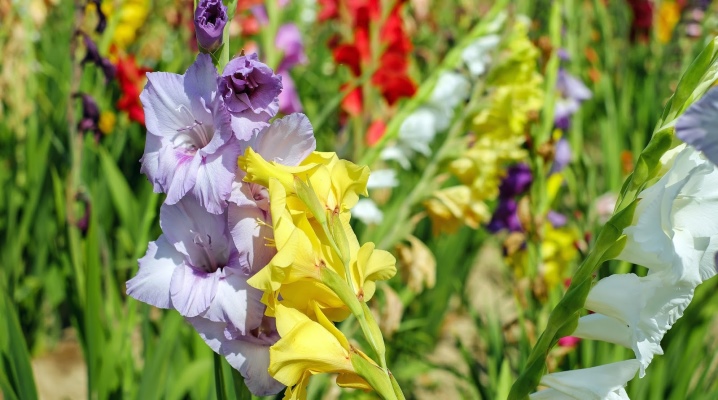
Gladioli are rightfully considered the kings of garden beds, but few of the novice florists know what the skewer bulbs look like, how to propagate and preserve them in winter. In order for this plant to feel truly comfortable in the vastness of the middle lane and in other climatic zones, you need to carefully approach its planting. With the right approach, from skewer and other flowers similar to gladiolus, you can create incredibly beautiful compositions in the garden, and then enjoy their splendor throughout the warm season.



What it is?
Gladiolus, or skewer, is perhaps the most popular plant in garden beds. This name species of perennial representatives of the iris family received thanks to the xiphoid shape of the leaves. In ancient times, edged weapons were called gladiuses. As a result, the name obtained from him stuck in both the official botanical classification and in the Russian language. This herb for open ground is also called a skewer by analogy with a variety of blades, since it looks very characteristic.
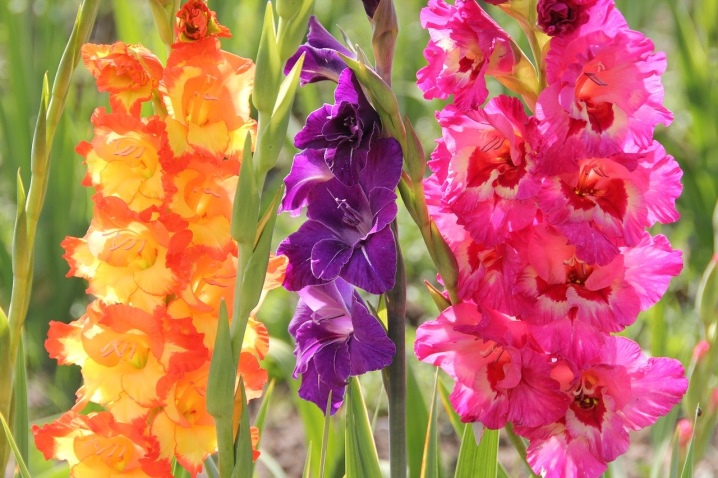
The geography of the growth of gladioli is quite extensive. The native land of the plant is considered to be the tropical and subtropical zone of Africa, the Mediterranean coast... In the wild, it is found in Eurasia, in Russia - in Western Siberia. The first mentions of the skewer can be found in sources from the times of Ancient Rome. The plant was eaten, used as a talisman.
In the garden culture, it became the most widespread at the end of the 16th century. Gladioli flourished in popularity in the 17th century, when South African species of these plants were introduced to Europe.
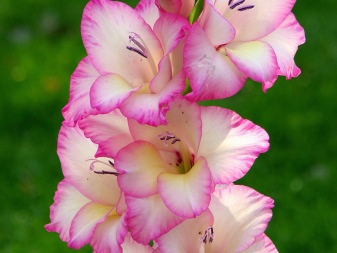
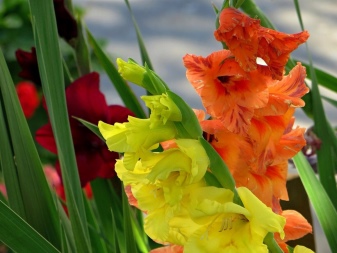
All modern garden varieties of skewers are hybrids, Gladiolus x hybridus hort... Gladioli belong to the category of corms - reproduction most often occurs with the help of underground shoots. The perennial growing rhizome is renewed annually, "children" grow on it. The corm shell has a scaly structure, the color range is from white to dark cherry, almost black.
The structure of gladioli implies the presence of a straight, upwardly directed stem that grows up to 150 cm in height. A leaf rosette is formed around it, closing around the main rod. This structure gives strength, allows you to withstand significant loads when spike-shaped inflorescences are formed. The leaves of the skewer are dense, bluish-green in color, have a xiphoid or narrower linear shape, grow up to 80 cm in length.
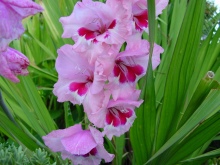
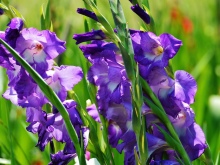
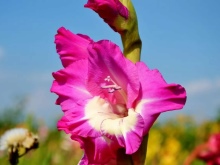
Early varieties of gladioli bloom in late spring, late ones retain their decorative effect until late autumn. It is believed that plants regenerate and re-pollinate, losing their varietal identity, but in fact, shredding or discoloration is most often associated with aging of the planting material. This can be avoided by timely updating the bulbs, replacing them with "kids" - tubers. The fruits of the plant are in the form of boxes with 3 valves, inside there are small brown seeds of a round shape.
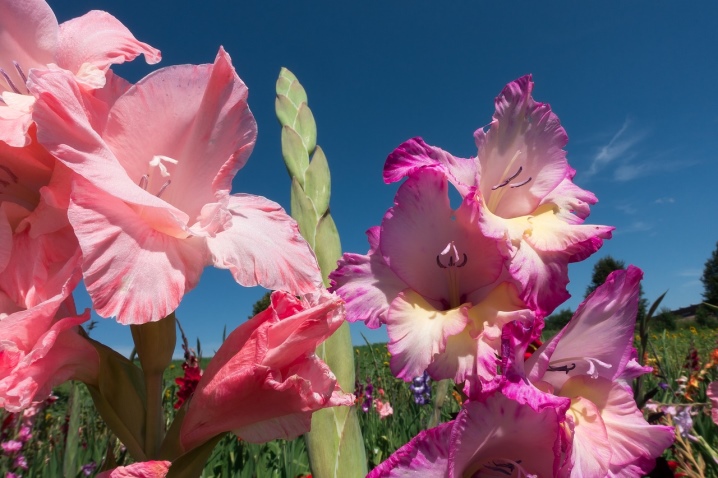
Gladiolus has a characteristic inflorescence: in the form of a spiral or two-sided spike, growing up to 80 cm in length. Its density varies from low to high. The flowers have petals fused at the base, forming a funnel, lobes of unequal size.Their color depends on the species and variety, very diverse.
Skewer inflorescences are used for cutting and forming bouquets, the stems separated from the parent plant remain up to 12 days.
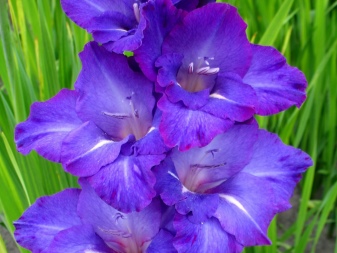
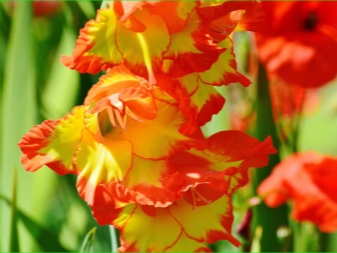
Flowers similar to gladioli
All flowers of the iris family are quite similar to each other. Unsurprisingly, they are often confused with gladioli. There are a number of species, upon meeting which one can decide that this is a skewer.
Among the often misleading plant growers are the following.
- Ixia... This representative of the iris family belongs to the category of cultivated artificially bred hybrids. Ixia also has characteristic leaves, propagates by bulbs, and has a varied color of petals. Care and planting rules for these species are identical, but the flowering time for an exotic guest in Russian gardens is much shorter, the flowers are star-shaped, the ear is formed only at the top of the stem.
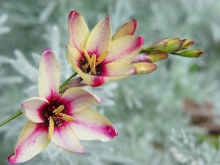
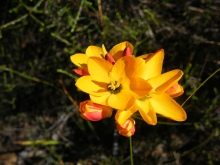
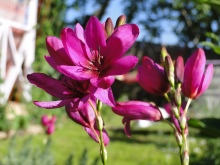
- Snapdragon... This type of herbaceous perennial is most often confused with gladioli due to its similar height, stem shape and flowers. Snapdragon, due to its low cold resistance, is most often grown as an annual plant. Upon closer examination, the difference in the shape of the inflorescence becomes obvious, but at first glance it is really easy to confuse.
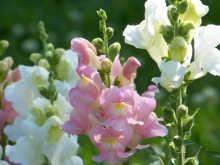


- Tigridia... She also belongs to the iris family, at the same time looks like an iris and a daffodil. Tigridia has characteristic xiphoid leaves and an erect stem, propagates by bulbs and is characterized by a long flowering period.
There are also differences - mainly with regard to the inflorescence. It is located on top, and not in the form of an ear, single, the petals fly around 8-10 hours after the bud opens.
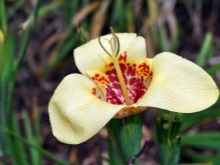
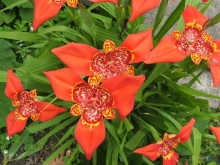

- Mallow... This plant is not at all related to the skewer, however, it is often considered one of the many varieties of gladioli. In fact, mallows are stockroses, most often grown on a two-year basis, with flowering only 2 years after planting. It is difficult to visually distinguish them from a skewer, but here there is a completely different shape and arrangement of leaves, in addition, the buds are not located in an ear, but individually, the number of petals in them varies from 5 to 15 pieces.
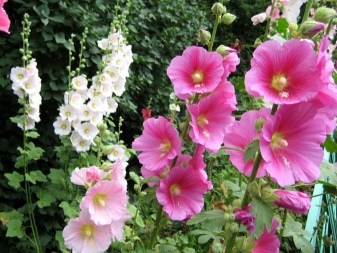
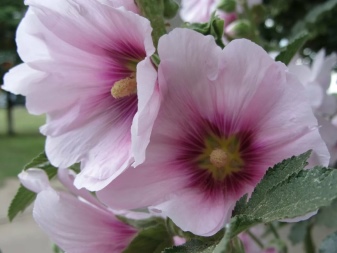
It should be noted that despite a sufficient number of similar species, gladiolus remains unique in many ways. He is always larger and more massive than his fellows, easily tolerates a cold snap.

Review of popular species and varieties
Skewer is a plant widely represented in nature, more than 200 of its species are known and described. The most beautiful and decorative ones are used in landscape design. Gladioli look great in alpine slides and landscape compositions, they create spectacular flower beds with them. Among the hybrids are velvet and ordinary plants, terry and smooth-petal... The color scheme is also quite diverse, especially the favorite plants of smoky gray and purple, raspberry, pink and peach flowers.
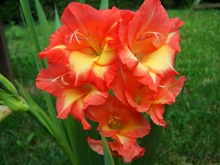
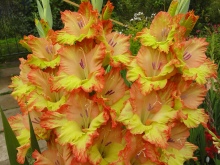
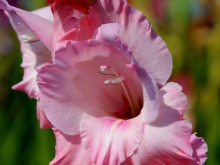
Even the names of the varieties sound incredibly poetic. "Light Breath", "Rowan in the Snow", "Golden Antelope", "Love Potion", "Aphrodite", "Silver Stream" - this is just a small part of the names loved by millions of flower growers. It is not surprising that it can be very difficult to opt for one thing. For beginner flower growers, the following popular varieties of skewer can be recommended.
- "Because gladiolus"... A variety with strongly corrugated flowers of an unusual two-tone color - yellow edges, pink-lilac background. The buds are medium in size, they look very impressive, out of 20 in an ear, up to 8 of them can be opened.
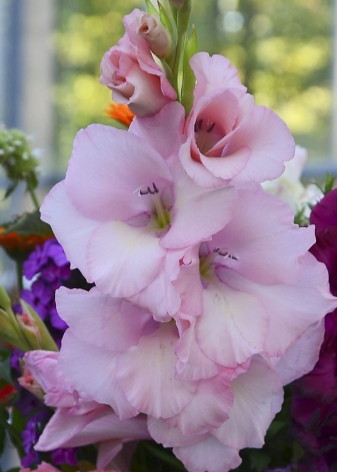
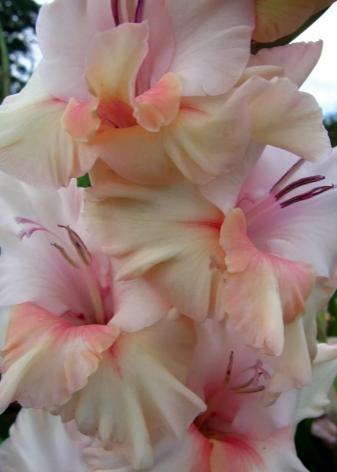
- "Easy breath"... A luxurious variety of lilac-crimson color with a bright border along the edge, has large corrugated flowers up to 16 cm in diameter. The variety is resistant to bright sun and other weather factors. Blooms early.
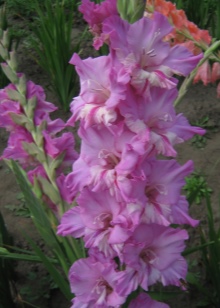
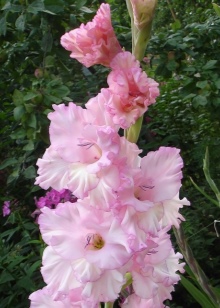
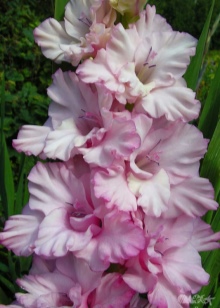
- "Sadko"... Tall - up to 180 cm, a variety with a powerful two-row spike and densely lying flowers.The shade of the petals is golden in the center, then lilac, with pronounced edging and ruffled lace at the edge.
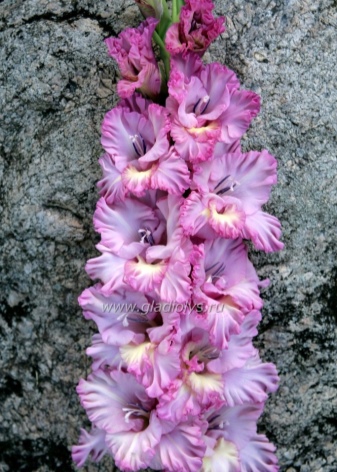
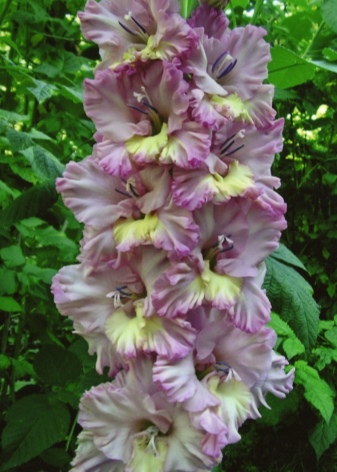
- "Moscow white stone"... A highly corrugated variety of Russian selection, it is distinguished by large snow-white flowers, it grows up to 150 cm.
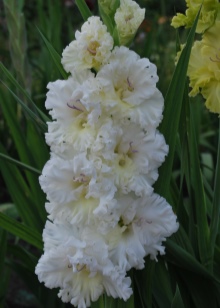

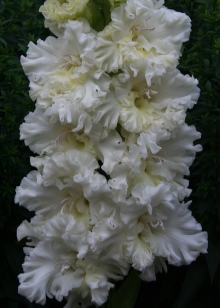
- Dragon Pearl... An unusual variety with black and burgundy petals and elegant fringes around the edges.
It can bloom as early as 1 year of planting.
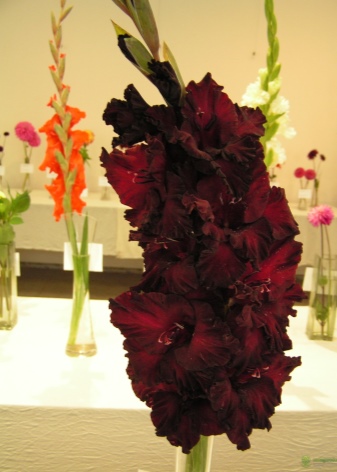
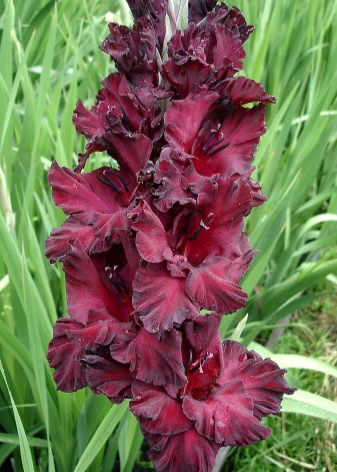
- "Unexpected joy"... An incredibly popular variety of yellow terry gladioli with tints of lemon and pink.
One of the most persistent options, it is protected from pests and diseases.
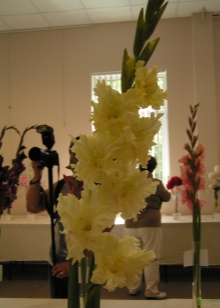
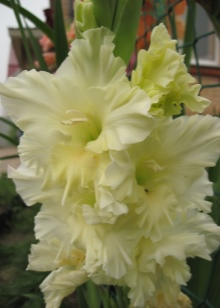
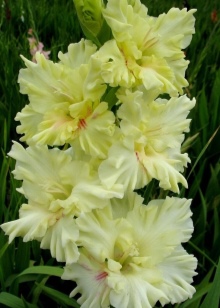
- "Blue Topaz"... A real garden gem with a medium-sized stem and deep blue, highly corrugated flowers.
The variety blooms early, but is quite sensitive to planting conditions.
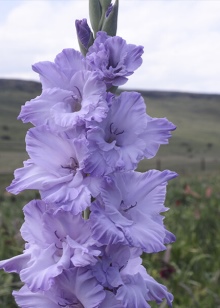
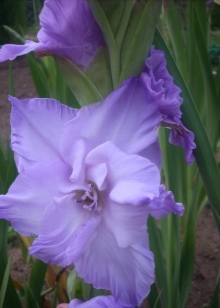

Ordinary
The most common type of gladioli, planted as part of rabatki and mixborders, possibly greenhouse cultivation. The size of individual flowers reaches 4 cm, the stem is long, up to 1.5 m, the shade of the petals is light purple. The frost resistance of the plant is high, the common skewer hibernates well even without shelter, but it does not tolerate planting in clay soils.
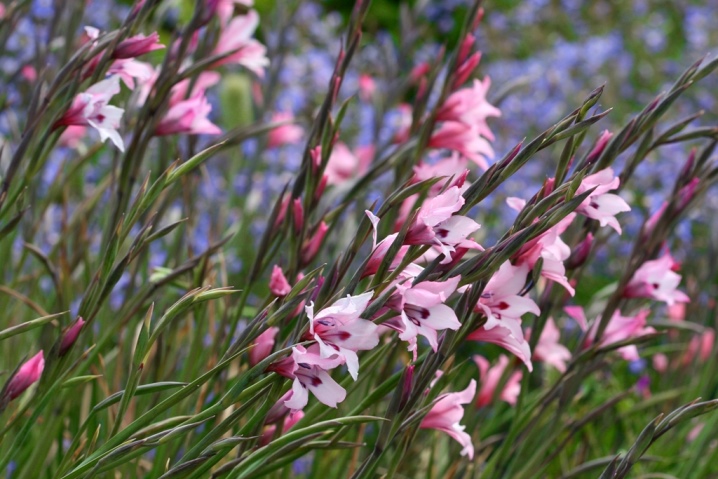
Tiled
Natural look, especially good when used in mixborders. Gladiolus tiled grows up to 80 cm, has not very large flowers, collected in ears. The color is predominantly purple, from light to dark, albino variants are found.
This type of skewer is highly winter-hardy and can do without artificial shelters. The plant is sensitive to the intensity of watering, blooms early, from June to July.
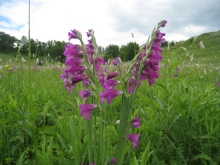
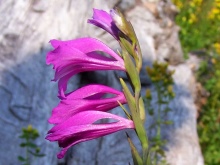
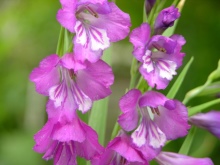
Muriel
A plant belonging to the genus Acidantera for a long time. It was ranked as gladioli already in the 20th century. The stem of the Muriel skewer grows up to 1 m in height, supplemented by 2 leaves, in an ear of up to 10 large flowers up to 8 cm in diameter. The buds bloom at the end of summer and remain decorative until autumn.
For gladiolus Muriel, a two-tone color is characteristic, the edges of the petals are always snow-white. The central part can be black, purple, deep crimson.
This species is cultivated as a garden plant, is characterized by low frost resistance - in winter, corms must be transferred to a dry place protected from frost.
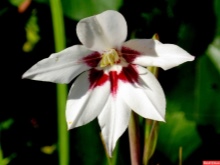
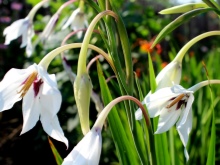
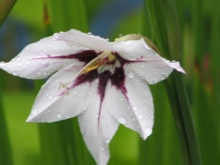
Swamp
Natural species, characterized by increased moisture content. It is especially popular among lovers of alpine landscapes, fits well with the design of rockeries and slides. With the help of a swamp skewer, you can effectively decorate the shores of reservoirs... The species differs from its cultivated counterparts in a small stem height - no more than 30-60 cm, flowers up to 3 cm in diameter. The shade of its buds always has a dark purple color.
When planting marsh gladiolus, it is important to choose highly moistened soils for it. This is a good option for planting in wetlands or low-lying areas.
The plant blooms in mid-summer, not too abundantly. Corms do not need additional protection, they have a dense shell.
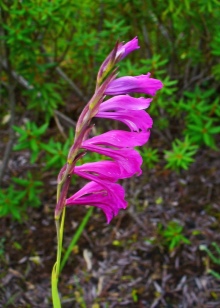
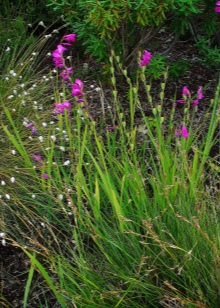
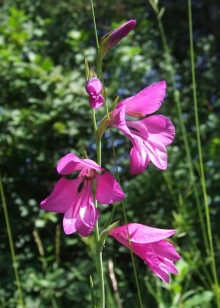
Thin
Natural species, refers to repeatedly flowering plants. The length of the stem can reach 70 cm; one-sided ears of 2-12 flowers are formed on it. The shade of the petals ranges from pink to dark purple. The thin skewer is found in Eastern Europe, in the south of Russia. The plant is characterized by high moisture content, early flowering - it begins in May. It is one of the rarest natural species of gladiolus, listed in the regional Red Data Books as endangeredin need of protection.
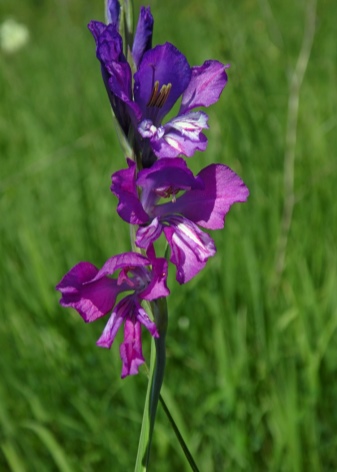
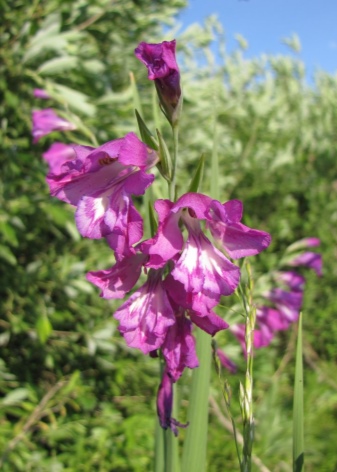
Seat selection
When planting gladioli, the correct location is of great importance. Hybrid and cultivated varieties need sunny areas, well protected from wind and other negative influences... Flowers feel great in planting curbs along fences, hedges, they can be planted against the wall of the house or along the paths. Wild species prefer swampy or well-watered soils... For them, choose places in lowlands or around water bodies.


The photophilousness of gladioli is so high that its late varieties may simply not bloom when planted in the shade. For the early adopters, this factor is not so sensitive, they tolerate partial shade. But the timing of the beginning of flowering will also be shifted. In addition, protection from the wind should not be total: without ventilation, favorable conditions for the reproduction of fungal crops are formed in the soil.
When choosing a place, it is worth considering which plants were placed on the ridges or flower beds earlier.
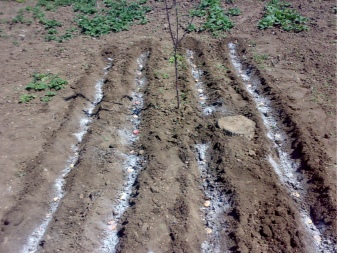
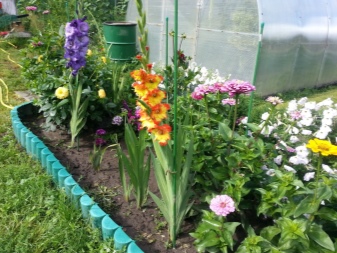
For the skewer, legumes and other vegetable crops, herbaceous perennials will be the best predecessors. You should not plant corms in the ground after asters, root crops.
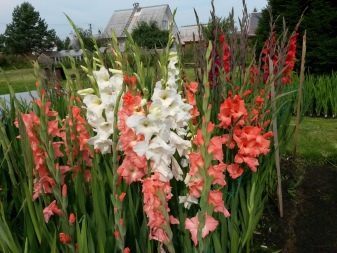
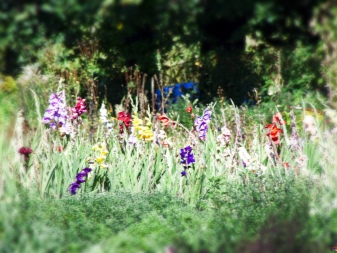
Landing features
Gladioli like soil that is well loosened and easily saturated with moisture. It is important that the turf in the country is rich in humus and fertile. The optimum acidity is close to neutral.
In addition, the following guidelines should be considered.
- In the spring, before introducing the bulbs into the soil, the area allotted for planting is carefully dug up, adding fertilizers to it. Compost or humus in a volume of 12 kg per square meter is suitable. It will also be useful to add mineral flower complexes in the amount recommended by the manufacturer.
- If there is a large volume of clay in the composition of the soil in the area, its additional cultivation is necessary. To make the soil more fertile, it is recommended to apply a mixture of coarse sand, gravel and wood ash (from 500 g per m²).
- When planting cultivated varietal gladioli in areas with lowlands or high soil moisture, care should be taken to form embankments with good drainage. It is in them that the flowers will be planted. The height of such ridges should be at least 30 cm.

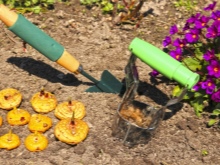
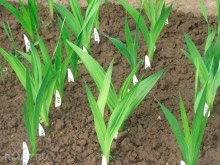
The planting process is not difficult for an experienced summer resident. In the spring, the corms are taken out of their storage area, subjected to a thorough examination. For planting, only those that have retained a dense structure are suitable, do not have spots, ulcers, and wet areas on the surface. They are taken out 7 days before being placed in the ground and left in a lighted place for sprouts to appear. This approach will help to reject non-viable planting material.
On the eve of planting, it is important to soak the corms in a solution of manganese or special antifungal drugs.... After such treatment, they will not be afraid of the development of diseases. The best time for planting a skewer in open ground is in the 2nd or 3rd decade of May, when the soil acquires a stable temperature of +10 degrees and above.
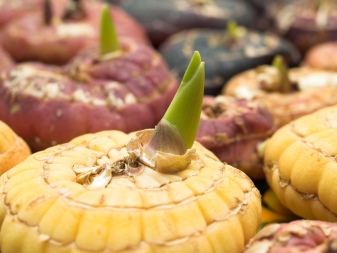
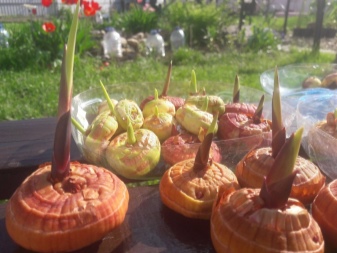
It is important to form a sand cushion with a thickness of 10-20 mm in each hole. Corms are planted to a depth of 8-12 cm, this indicator depends solely on the diameter of the shoot itself. The distance between plants is 25-40 cm, and the higher the variety, the greater it is. Upon completion of planting, the soil is watered, the water should be warm.

Seedlings will appear after 1-2 weeks. If there were already sprouts on the corms, the process will go faster. If the soil is warm enough, short-term frosts will not harm the plant. It is important to remember that gladioli cannot be planted in one place for more than 2 years... In addition, children and adult corms are not placed nearby.
When planting material of Dutch selection, it is worth considering that the lush and abundant flowering declared by the nursery will be one-time - within 1 year after planting.

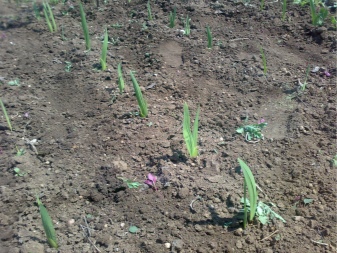
Care rules
Good growth and abundant flowering at the right time for gladioli provides proper care. First of all, when young shoots emerge, the soil is mulched as soon as the sprouts reach a height of 10 cm. The thickness of the mulch layer of 50 mm in the first month will allow varieties that are afraid of frost to survive the drop in temperature.In the future, such a bedding will make the microclimate in the root zone as comfortable as possible, and will provide additional nutrition.
Among the recommendations for the care of gladioli, the following points can also be highlighted.
- Garter... During flowering, the skewers begin to lean to the ground, they need stands or support to keep the stem straight. The garter is made immediately after the buds are formed on the arrows. After opening, the flowers that have begun to fade are necessarily cut off. This will leave the plant much more energy to form seed pods.
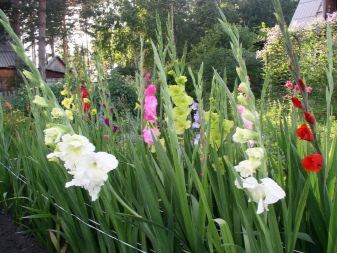

- Watering... Gladioli are moisture-loving plants. But this does not mean that they need to be watered frequently. The usual scheme is once a week, in the morning or evening, in a volume of 10 liters per m², in the heat they begin to add liquid more often, every 3 days. This is especially important during the period of bud formation so that they bloom on time and do not fade.
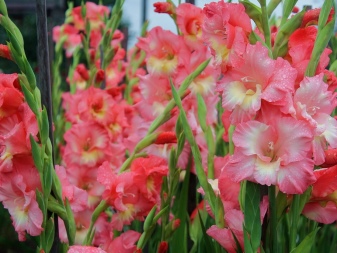
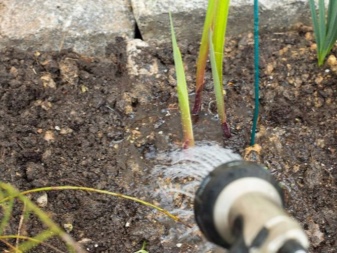
- Weed removal... Weeding of the site is carried out monthly from the moment of planting. When mulching, weed growth will not be too intense, but they will still appear. ...
It is optimal if maximum attention is paid to weeding from the beginning of bud formation until the end of flowering.
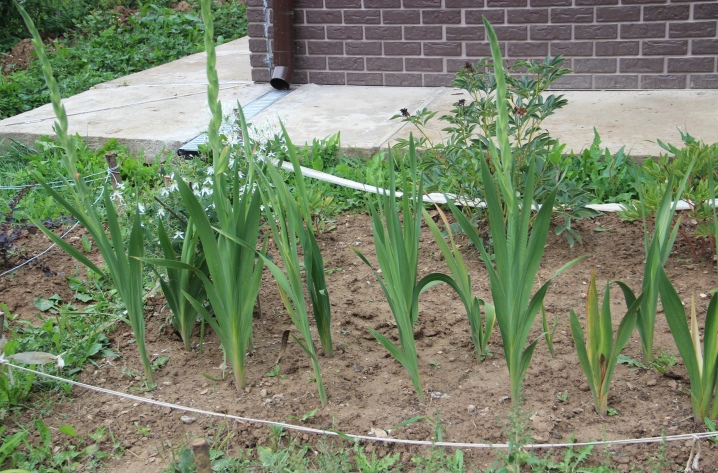
- Fertilization... It is produced according to a strictly stipulated scheme. Nitrogenous compounds are applied in the spring, when 3 true leaves appear, ensuring sufficient saturation of the soil with the necessary substances for the growth of green mass. After 6 leaves are released, a complex potassium-nitrogen-phosphorus fertilizer is applied. 3 feeding is performed during the formation of buds, potassium chloride and superphosphate are used.

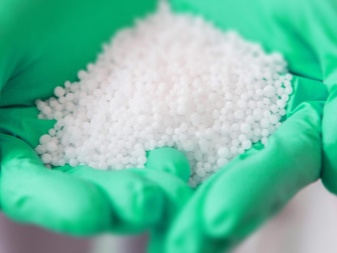
- Corm harvesting... It takes place from 35 to 45 days after the end of the flowering period. By this time, strong scales will appear on the corms and children ready for harvesting. They are dredged in dry weather, starting with early varieties and ending with late ones. The green mass can be cut in advance or cut with pruning shears later.

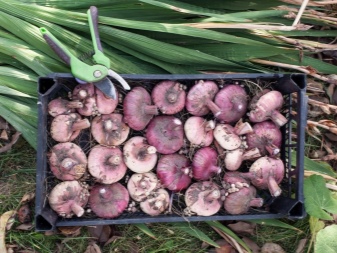
When choosing a place for planting early, autumn tillage is necessary. Potassium-phosphorus fertilizers are introduced into it, then the soil is dug up and left for the winter. In the spring, the soil is saturated with potassium, chlorine-free formulations are suitable. The digging depth will be less, about 10 cm.

Reproduction
Wild species of skewer reproduce mainly by seed. But if you breed it for breeding, cultivars are better formed by division. It is this path that allows the offspring to completely preserve the characteristics of the parent plant. "Roots" of gladiolus - corms, give buds (or babies) annually, in an amount of 1 to 20 pieces, depending on the variety.
It doesn't take much effort to propagate a plant vegetatively. It is enough just to collect the tuber from the bulb in the fall, dry them thoroughly for 2-3 weeks. Then the planting material is sorted, taking away children without signs of spoilage, rot, sent to dry in wooden boxes, covering them with a newspaper... After 1.5 months, you can wrap them in paper and place them in the vegetable drawer of the refrigerator for storage. Prepared in this way for planting, they will remain viable for the next 2-3 years.


To obtain seedlings, it remains only to free the bulbs from the shell, immerse them in warm water for 24 hours, and then plant them in a container in flower soil. After germination, gladioli care is similar to that of adult plants. It is only important not to forget to cut the peduncles, so that the plant will let all the forces into the root..
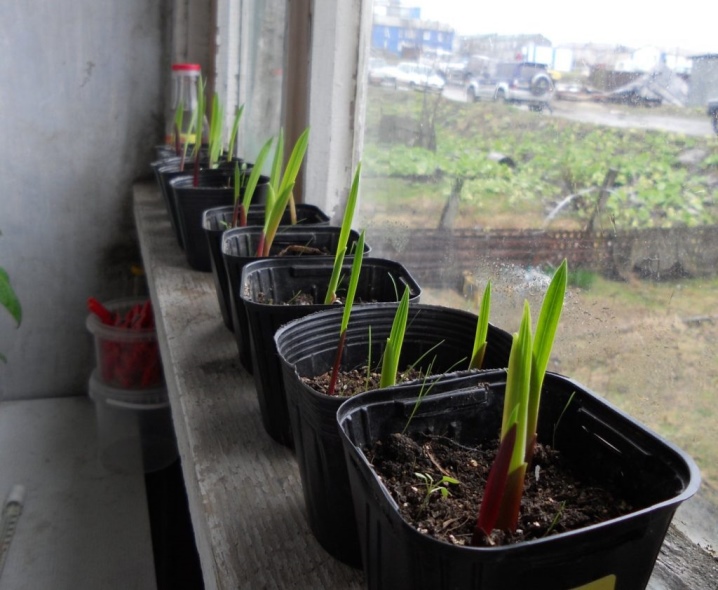
You can also propagate the skewer by dividing the bulbs. For this, formations of 2-3 years of life are suitable, which are divided into 2-3 parts before planting, having processed the cuts with coal or cinnamon. The slices are placed in the ground, bottom up.
When choosing a seed propagation method, you need to germinate planting material in spring or at the end of winter.The collected seeds are placed in a container, under a special lamp, after soaking them in a growth stimulator.
At home, cultivation is carried out until the end of May, then the seedlings are transferred to open ground or left on the balcony, outside in pots.
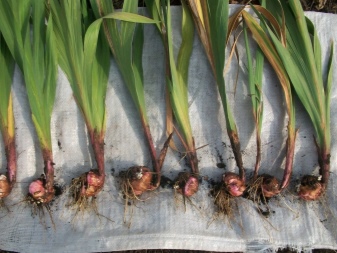
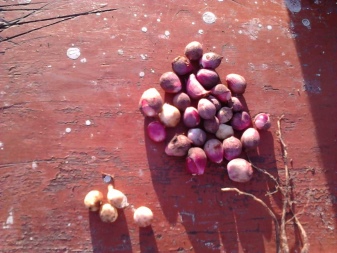
Beautiful examples in the garden
In landscape design, spectacular compositions with gladioli are very popular. With the help of flowerpots with them, you can decorate a terrace or porch. It is good if plants of different colors are collected in one vessel., giving the necessary brightness and richness of colors. This decor element goes well with cobblestone and brick walls, flagstone, curly ivy as a background.
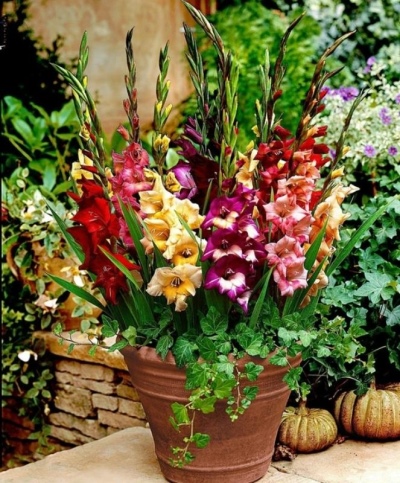
On a flower bed, gladioli are in harmony with other plants in mixborders. When decorating the composition, it is important that tall flowers are in the background, serve as a background, but do not protrude forward. Such combinations look especially impressive when surrounded by a green lawn.
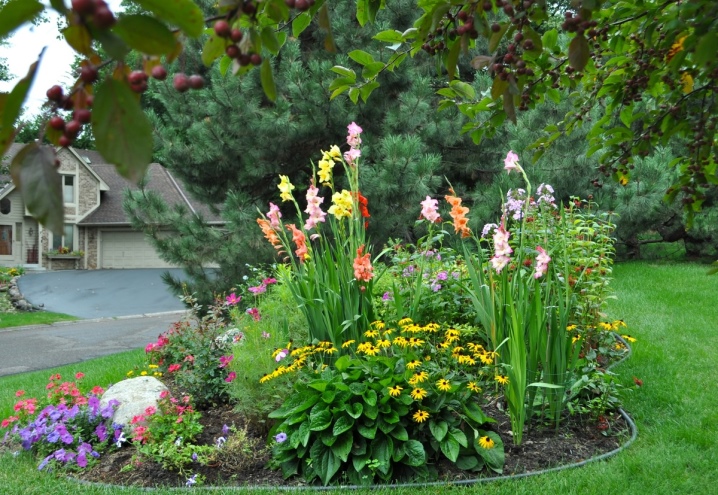
When forming landscape compositions with gladioli, it is important to emphasize the royalty of this representative of the iris family. A monochromatic varietal planting looks good in a group, against the background of conifers and shorter carnations. Such an ensemble will easily decorate the facade of the house and the view from the window.
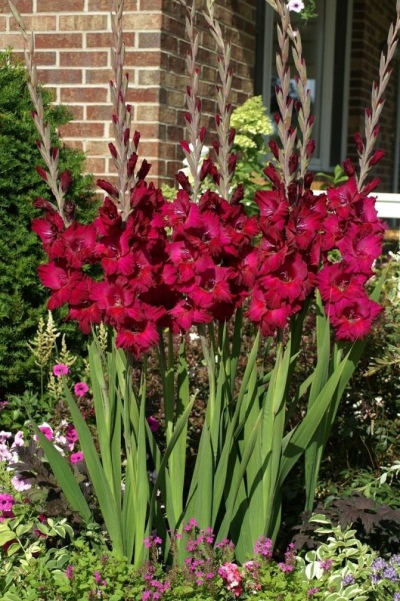
For information on how to plant gladioli correctly, see the video below.







































































































The comment was sent successfully.